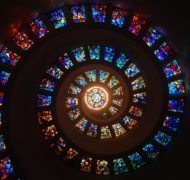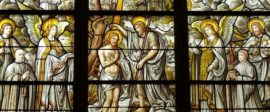God at Work: Seeing and Reflecting God the Craftsman and Artist (Jeremiah 18 Sermon Notes)
Sermon Notes / Produced by The High Calling
Scripture: Jeremiah 18:1-6
The word that came to Jeremiah from the Lord: “Come, go down to the potter’s house, and there I will let you hear my words.” So I went down to the potter’s house, and there he was working at his wheel. The vessel he was making of clay was spoiled in the potter’s hand, and he reworked it into another vessel, as seemed good to him. Then the word of the Lord came to me: Can I not do with you, O house of Israel, just as this potter has done? says the Lord. Just like the clay in the potter’s hand, so are you in my hand, O house of Israel. (NRSV)
Theme: Art is the expression of a seeing heart through attentive hands. Seeing and Reflecting God the Craftsman and Artist: Starts with seeing… Is expressed in shaping… Produces something beautiful and useful… Conclusion: To reflect “God the Artist,” you must first see yourself as a work of art.
Sermon Development: A few years ago, I was invited by one of the contractors in my town to go to a job site. This contractor had recently lost his young daughter in a freakish and sudden passing, and the company that he worked for wanted to dedicate the building to her memory. They asked me if I would lead a brief service at the site. So, I drove to the place on a dreary day and parked my car in the dirt lot adjacent to the building site. I got out of the car carrying my Bible and wearing my serious Sunday suit. The mud immediately caked over my wingtips, and I plodded my way to the center of the foundation where the walls were just going up. The project director called over the whole crew, asking them to stop their work for a few minutes.
It didn’t take me long to realize that these men had no idea who I was and probably didn’t know the young girl either. They were respectful, but annoyed. They were both bored and were falling behind; they had work to do. So, I briefly explained our purpose in gathering, looking (to no avail) for some sign that they appreciated this little ceremony. Seeing little encouragement, I plunged into my remarks, trying not to take them away from their work too long.
I began by telling them of when my wife Beth and I went to Notre Dame Cathedral in Paris, France. We took the tour up the bell tower and walked up a stairway that had been recently constructed to handle the weight and pounding that the tourists would deliver. As we walked up the stairs, we paused at an opening in the bell tower. I looked down and realized that I was gazing at the back of an intricate sculpture of a gargoyle on a ledge high above the street. Then, as I sat staring at the beauty of this piece of handiwork, it dawned on me that the artist who had carved it so many centuries ago, never expected that the back of this sculpture would be seen. You see, the vantage point from which I looked at it didn’t exist in the original design of the cathedral. The stairway hadn’t been there; no one was supposed to be able to gaze out this opening. The only one who would have seen the backside of this sculpture was God. And those church craftsmen, so many years ago, had created art that only God could see—reflecting in the very excellent attention to detail—the character of God.
As I finished the story, I noticed a change had come over these workmen. They were no longer shuffling their feet or fidgeting with their hands. They stood there in rapt attention for I was talking to them about their work. They were rough carpenters and ironworkers; they were electrical conduit and pipe layers. No one ever saw their work. But I had challenged them in the memory of our young friend, and for the glory of God, to make their work art. And to do it for the one audience who was sure to see. As I finished, one by one, a number of the men thanked me. For though none of them would have considered themselves artists or craftsmen, they had caught a glimpse of just some of what it means to see and reflect the God who is.
It might seem odd to think of God as an artist or craftsman. We tend to think of his creative activity as being one of immediate and effortless commanding, not patient and laborious shaping. Yet, that is the very image that flows throughout the Scriptures. “When I consider the work of your fingers, the world’s your hands have made,” Psalm 8 reminds us. “He who created the heavens, he is God, he who fashioned and made the earth,” Isaiah tells us.
God’s people drew upon the crafts of the day—of silver and blacksmiths with their fiery furnaces, of potters shaping and forming—to talk about the way they experienced God at work in the world and in their lives. For the people of God, there is something artistic, even poetic, about God’s activity. In the text from Ephesians 2:10, the word for the phrase “what he has made us” is the root word from which we get the word “poem.” We are God’s work of poetry, created to express his creativity in our lives.
So let me offer these thoughts, to affirm our artistic friends and maybe to help those who, like me, struggle with feeling very creative. Let me offer this little primer in Godly Art Reflection 101, to help each of us see and reflect God the craftsman and artist:
Theme: Art is the expression of a seeing heart through attentive hands. It starts with seeing, is expressed in shaping, and produces something beautiful and useful.
Starts with seeing… According to my wife, the artist, the reason why so many of us feel so uncreative, is that we refuse to take the time to see things as they are rather than the way we think they are. And when we try to draw or paint, or sculpt something, we fail. Since we really don’t see it, we can’t make it. We look past things and people and all of creation and see what we want to see, or what we think should be there.
I remember walking through the Louvre in Paris the day before I went to Notre Dame. There were hundreds of people packed into the hallways, racing through this “must see” tourist stop. Most of them with heads down, looking in a guidebook searching only for the Mona Lisa that “everyone” has to see. Others searched frenetically for a gift shop or a bathroom. But, all around them were the most beautiful works of art in the world, and most of them just sat silently, simply ignored.
Like Michelangelo who saw David in a huge slab of flawed marble, if we are going to see and reflect a creative God, we need to begin by asking God to open our eyes to really see the people and the world around us in all their depths. To gaze into the eyes of another and not just at them. To see the pain of the world past the headlines, the need of people past our small circle of friends, to really see the joyful and creative work of his Spirit. It starts with seeing and:
Is expressed in shaping… The most common work of art in the Bible is the work of the potter. Pottery in the oldest verses of Scripture was not the dynamic process of the wheel and water, but the slow molding and shaping of strong, attentive hands, forming the lifeless lump of clay into a vessel to hold the stuff of life. Throughout the Bible, God is described as the one who shapes the pot and adorns it with that which lets it stand apart, be unique, and be pleasing to the eye.
Shaping is a long, dynamic, and fluid process with many fits and starts. At times, the potter finds the clay unmalleable and must break it and work it and wet it until it can be shaped according to his design. And at times, a vessel that is useful for one task must be reshaped for other tasks. In the Scriptures, there is a sense that God uses the events of life, the trials and circumstances, to shape his creation—that the world is shaped by history, that people forge a national identity, that some are formed by circumstances, or that a person had a spot carved for himself.
This is a good reminder to us that creativity is as much patience and effort as inspiration. That the creative expression of God in our families, in our children’s lives, or in our work will come from a long, constant and persevering shaping.
Seeing and reflecting God the craftsman and artist, starts with seeing is expressed in shaping, and finally
Produces something beautiful and useful…. Creativity, if it is to be truly creative, produces something. It is taking good intentions and making something of them. And I believe for everything created to reflect God, “that something” must be both beautiful and useful.
I know—immediately some of you will object that beauty is in the eye of the beholder and that what is beautiful art to one person is a black velvet poster of Elvis to another. But the classic sense of beauty is based on the notion that aesthetics are tied to ethics and that the beautiful is the good. Creative acts, if they are to reflect God, must be good to be beautiful: they must inspire goodness or make us yearn for goodness, even amidst badness.
Even art that reflects the tragedy and folly of the world must do more than show it to us. If it is going to be truly prophetic, then in the words of Walter Brueggemann, it must criticize and energize. To be truly a thing of beauty, art must reflect the God who is truly good. Which leads to the second criteria.
Art that reflects God must be both beautiful and useful.
Immediately some of the more practical among us perk our ears. Did he say useful? Now he’s talking. That’s the problem with art, they say, what good is it? I mean if you want be creative, build a better mousetrap, design a computer that won’t crash right in the middle of doing payroll, develop something that mows my lawn while I am watching the World Series. Now that is beautiful! And biblically speaking, most works of art were household items: pots, vessels, and urns.
But art’s primary use is to give us a glimpse of the divine in the mundane: It is to show us God. This doesn’t mean that all of our photographs need to have Bible verses or that all of our themes must be consciously religious, but that all that we do must be done to and for the glory or revealing of God. And any creative act, if it is a reflection of God, reveals something of God, calls people back to God, inspires worship of God, or simply causes us to sigh, “My God!” is useful to the Lord.
In 1 Chronicles chapters 22 and 29, we see that the craftsmen who worked on the temple of God were dedicated to God and were blessed by God to do their creative work. Of course, some of them worked on ornamentation that was seen in worship, but the craftsmen who carved the doorjamb or the subflooring were equally blessed.
I believe that part of our vocation as people called to reflect God in the world is to reflect the God who is so constantly creative. Whether it is finding creative solutions to problems, bringing imagination and wonder to your parenting style, or lovingly shaping the environment of your neighborhood, workplace, or home, I believe that we are to do everything like those cathedral craftsmen carving the backs of gargoyles for Notre Dame: doing it for God’s approval and delight.
And when we do so, then we have seen, shaped, and produced something beautiful and useful.
Tod Bolsinger has been the Senior Pastor of San Clemente Presbyterian Church in San Clemente, California, since 1997. Previously he served for ten years at First Presbyterian Church of Hollywood. He earned a Ph.D. in Theology and Master of Divinity from Fuller Theological Seminary. He teaches for Fuller Seminary and Denver Seminary, is the author of two books, It Takes a Church to Raise a Christian and Showtime, blogs at http://bolsinger.blogs.com, and consults for TAG Consulting.



.jpg)







